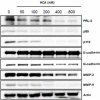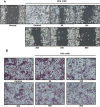Antimetastatic effect of halichondramide, a trisoxazole macrolide from the marine sponge Chondrosia corticata, on human prostate cancer cells via modulation of epithelial-to-mesenchymal transition
- PMID: 23860239
- PMCID: PMC3736435
- DOI: 10.3390/md11072472
Antimetastatic effect of halichondramide, a trisoxazole macrolide from the marine sponge Chondrosia corticata, on human prostate cancer cells via modulation of epithelial-to-mesenchymal transition
Abstract
Halichondramide (HCA), a trisoxazole-containing macrolide isolated from the marine sponge Chondrosia corticata has been shown to exhibit cytotoxicity and antifungal activities. In our previous study, HCA was also found to exhibit antiproliferative activity against a variety of cancer cells. However, the precise mechanism of action of HCA in the antitumor activity remains to be elucidated. In the present study, we identified the antimetastatic activity of HCA in the highly metastatic PC3 human prostate cancer cells. HCA showed potent growth inhibitory activity of the PC3 cells with an IC50 value of 0.81 µM. Further analysis revealed that HCA suppressed the expression of a potential metastatic biomarker, phosphatase of regenerating liver-3 (PRL-3), in PC3 cells. The suppression of PRL-3 by HCA sequentially down-regulates the expression of phosphoinositide 3-kinase (PI3K) subunits p85 and p110. The antimetastatic effect of HCA was also correlated with the down-regulation of matrix metalloproteases (MMPs) and the modulation of cadherin switches N-cadherin and E-cadherin. In addition, HCA also effectively suppressed the migration and invasion of PC3 cells. These findings suggest that halichondramide might serve as a potential inhibitor of tumor cell metastasis with the modulation of PRL-3.
Figures






Similar articles
-
Anti-proliferative effect of (19Z)-halichondramide, a novel marine macrolide isolated from the sponge Chondrosia corticata, is associated with G2/M cell cycle arrest and suppression of mTOR signaling in human lung cancer cells.Toxicol In Vitro. 2013 Mar;27(2):694-9. doi: 10.1016/j.tiv.2012.11.001. Epub 2012 Nov 9. Toxicol In Vitro. 2013. PMID: 23147639
-
Down-regulation of E-cadherin enhances prostate cancer chemoresistance via Notch signaling.Chin J Cancer. 2017 Mar 29;36(1):35. doi: 10.1186/s40880-017-0203-x. Chin J Cancer. 2017. PMID: 28356132 Free PMC article.
-
Phosphatase of regenerating liver-3 inhibits invasiveness and proliferation in non-small cell lung cancer by regulating the epithelial-mesenchymal transition.Oncotarget. 2016 Apr 19;7(16):21799-811. doi: 10.18632/oncotarget.7985. Oncotarget. 2016. PMID: 26967563 Free PMC article.
-
Differential expression of epithelial and mesenchymal proteins in a panel of prostate cancer cell lines.J Urol. 2012 Aug;188(2):632-8. doi: 10.1016/j.juro.2012.03.114. Epub 2012 Jun 15. J Urol. 2012. PMID: 22704442
-
AMD3100 inhibits epithelial-mesenchymal transition, cell invasion, and metastasis in the liver and the lung through blocking the SDF-1α/CXCR4 signaling pathway in prostate cancer.J Cell Physiol. 2019 Jul;234(7):11746-11759. doi: 10.1002/jcp.27831. Epub 2018 Dec 7. J Cell Physiol. 2019. PMID: 30537000
Cited by
-
Marine Natural Products with Activities against Prostate Cancer: Recent Discoveries.Int J Mol Sci. 2023 Jan 11;24(2):1435. doi: 10.3390/ijms24021435. Int J Mol Sci. 2023. PMID: 36674949 Free PMC article. Review.
-
Expression of phosphatase of regenerating liver-3 is associated with prognosis of Wilms' tumor.Onco Targets Ther. 2017 Jan 10;10:311-317. doi: 10.2147/OTT.S107076. eCollection 2017. Onco Targets Ther. 2017. PMID: 28138254 Free PMC article.
-
Sponges: A Reservoir of Genes Implicated in Human Cancer.Mar Drugs. 2018 Jan 10;16(1):20. doi: 10.3390/md16010020. Mar Drugs. 2018. PMID: 29320389 Free PMC article. Review.
-
Inhibition of A549 Lung Cancer Cell Migration and Invasion by Ent-Caprolactin C via the Suppression of Transforming Growth Factor-β-Induced Epithelial-Mesenchymal Transition.Mar Drugs. 2021 Aug 19;19(8):465. doi: 10.3390/md19080465. Mar Drugs. 2021. PMID: 34436304 Free PMC article.
-
Can Natural Products Targeting EMT Serve as the Future Anticancer Therapeutics?Molecules. 2022 Nov 8;27(22):7668. doi: 10.3390/molecules27227668. Molecules. 2022. PMID: 36431766 Free PMC article. Review.
References
-
- Blunt J.W., Copp B.R., Keyzers R.A., Munro M.H., Prinsep M.R. Marine natural products. Nat. Prod. Rep. 2012;29:144–222. - PubMed
-
- Halim H., Chunhacha P., Suwanborirux K., Chanvorachote P. Anticancer and antimetastatic activities of Renieramycin M, a marine tetrahydroisoquinoline alkaloid, in human non-small cell lung cancer cells. Anticancer Res. 2011;31:193–201. - PubMed
-
- Nguyen H.T., Chau V.M., Tran T.H., Phan V.K., Hoang T.H., Nguyen T.D., Nguyen X.N., Tai B.H., Hyun J.H., Kang H.K., et al. C29 sterols with a cyclopropane ring at C-25 and 26 from the Vietnamese marine sponge Ianthella sp. and their anticancer properties. Bioorg. Med. Chem. Lett. 2009;19:4584–4588. doi: 10.1016/j.bmcl.2009.06.097. - DOI - PubMed
Publication types
MeSH terms
Substances
LinkOut - more resources
Full Text Sources
Other Literature Sources
Medical
Research Materials

